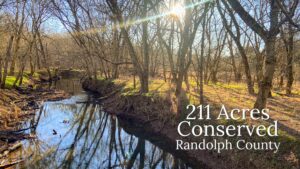
by Philippa Tanford, LandTrust intern summer 2015
May 20, 2015

Have you heard what sounds like a rusty bicycle making its way through the forest recently? That “squeaky wheel” is the signature sound of the Black-and-white Warbler, Mniotilta varia, a migrating songbird and summer resident in the deciduous and mixed forests of North Carolina and much of the Eastern United States. One of the earliest arrivals during spring migration, the sound of their song is a sure sign that summer is around the corner.
Though common, Black-and-white Warblers have always struck me for their distinctive characteristics, making them one of my favorite warblers. Unlike other warblers, which generally forage from a tree’s leafy canopy and thin outer branches, Black-and-white Warblers focus on the trunk and thicker branches of a tree. They behave more like nuthatches than their warbler relatives, moving both up and down tree trunks as they forage for insects. In moving down trees, Black-and-white Warblers and nuthatches take advantage of an otherwise unexploited niche, discovering nooks and crannies in the bark that upward-foraging woodpeckers and creepers generally miss. They are the only warblers that regularly behave this way, so it comes as no surprise that they are the lone member of their genus, Mniotilta.

I heard quite a few Black-and-white Warblers singing their high pitched squeaky song while hiking recently in Uwharrie National Forest with John Gerwin, the Curator of Ornithology at the North Carolina Museum of Natural Sciences. On a relatively steep slope of mixed forest we observed a female “chipping” (making short, single-note calls) with a mouth full of food, a good sign we were close to a nest. Although we tend to think of birds nesting in trees, the Black-and-white Warbler is one of many birds that nest on the ground. They form cup nests out of bark and leaf litter, and line them with dried leaves, hair, and moss. We moved some distance away in the hopes of watching her return to her hidden nest, and after several minutes she flew down into a small, shallow gully and disappeared. We found this particular warbler on her nest at the base of a shrub, and she was diligently still even when we approached within several feet.
Black-and-white Warblers’ use of moss in their nesting material is the source of their scientific genus name, Mniotilta. It literally means “moss plucker,” from the Greek mnios for “moss” and tilta for “pluck,” as they “pluck moss” to line their nests. The species name, varia, simply refers to their bold black and white striping. Males and female look very similar, both with contrasting black and white, but females have a clean white chin and a gray cheek, while males have black in both of these areas. Their coloration and pattern pretty easily differentiates them from almost every other songbird in their range, with the major exception of the Blackpoll Warbler, which has less striping but is also boldly black and white. However, the two species can be readily distinguished by their behavior and their temporal range. Blackpoll Warblers only pass through North Carolina during migration on their way to Canada or South America, so in early spring migration and during much of the summer you can be pretty sure you are seeing Black-and-white Warblers.
But Black-and-White warblers are migratory as well. After spending time with us in North Carolina for the summer, they will begin migrating back south for the winter along with most other warblers, where they can be found from southern Florida and Texas down to Colombia. Come next spring, look forward to the return of the Black-and-white Warblers and with them tidings of summer.